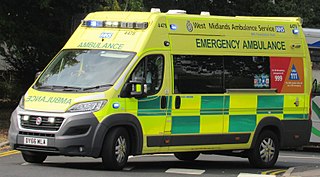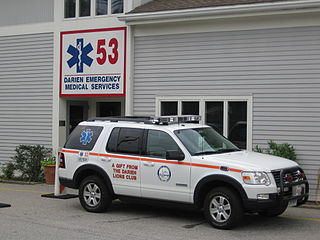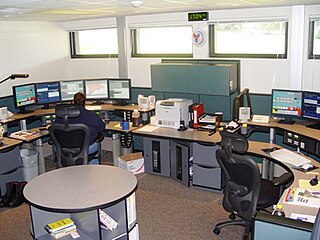In emergency medical services such as an ambulance squad, a refusal of medical assistance is the term for when a patient refuses any or all parts of medical treatment.
In emergency medical services such as an ambulance squad, a refusal of medical assistance is the term for when a patient refuses any or all parts of medical treatment.
The refusal of medical assistance, or RMA, ensures the continuum of care that ambulance squads have a responsibility towards. In a typical emergency call, the ambulance service will assess and transport the patient to an appropriate facility. The ambulance squad's duty towards the patient begins with patient contact and generally ends with transfer to the emergency department of the receiving hospital. The call can terminate in other ways; for example an ambulance service may cancel their own services if the patient becomes violent (scene safety), if they are canceled by on-scene personnel (such as the police or, in the case of a MICU service, the on-scene BLS EMT), or at the discretion of the dispatcher (if another ambulance is better positioned to take the call).
In general, once patient contact has been established, the ambulance service must either transport or obtain an appropriate refusal from the patient.
There are three general types of RMA, designated by scope. In the widest sense, the patient may even refuse to be evaluated by EMS. Generally, however, the patient will submit to an evaluation (consisting of vitals and an assessment) before asking or being asked about refusal by the EMS agency. Or a patient may refuse only specific actions, such as C-spine precautions.
As policy, ambulance services are usually unable to release a patient on their own - that is, a crew is usually unable to determine that a patient is fine (this is the job of the doctors in a hospital). Unofficially, it may be obvious that a patient does not need transport - in these situations, EMS personnel may 'guide' the patient towards an RMA.
The refusal is best suited for these situations; for example, a minor cut or bruise or uninjured parties in a motor vehicle accident. It can also be used where non-critical transport is advised, but it would be counterproductive to take the party by ambulance, e.g. an injured but fearful child could be comforted and transported to the hospital or doctor's office by the parent.
In general, ambulance squads are unable to contravene the wishes of a mentally competent patient. This may lead to situations of likely cardiac compromise, likely internal trauma, or other life-threatening situations. However, if the patient is of sound mind, they are generally able to refuse treatment. The EMS provider has limited options at this point, since EMS generally cannot restrain and take a person involuntarily. However, depending on local policy, the police may be able to place the patient in protective custody (essentially arresting the person and releasing them to the EMS agency). This option is not to be pursued lightly. This is typically termed the RMA-AMA (refusal of medical assistance against medical advice) to differentiate it from a standard RMA (which may be assumed to be the end to a trivial call).
Most EMS providers operate on the principle of informed consent; that is, patients must know exactly what it is they are refusing, and what the possible consequences might be, in order to make a proper decision. This precludes parties who are intoxicated or otherwise incapable of making an informed decision, such as the mentally incompetent. Otherwise, agencies could release someone who was not able to understand what refusing might mean to their health.
For similar reasons, minors (those under the age of 18) are generally unable to refuse medical care. In these circumstances, the crew can elect to wait for a parent or other legal guardian, who is able to.
Ideally, the refusal is a form provided by and filled out by the agency and signed by multiple parties - usually the EMS agency itself, the patient (or his legal proxy or guardian), and a witness (ideally a police officer). A copy is attached to the patient care report or otherwise secured and retained by the agency, and another copy is usually given to the patient. The patient is advised of the risks of refusal, including the fact that their condition may worsen, and advised to call 9-1-1 or the emergency number without hesitation if they feel the need.

Emergency medical services (EMS), also known as ambulance services or paramedic services, are emergency services that provide urgent pre-hospital treatment and stabilisation for serious illness and injuries and transport to definitive care. They may also be known as a first aid squad, FAST squad, emergency squad, ambulance squad, ambulance corps, life squad or by other initialisms such as EMAS or EMARS.

An emergency medical technician is a medical professional that provides emergency medical services. EMTs are most commonly found serving on ambulances.

A paramedic is a healthcare professional who responds to emergency calls for medical help outside of a hospital. Paramedics mainly work as part of the emergency medical services (EMS), most often in ambulances. The scope of practice of a paramedic varies among countries, but generally includes autonomous decision making around the emergency care of patients.
A medical emergency is an acute injury or illness that poses an immediate risk to a person's life or long-term health, sometimes referred to as a situation risking "life or limb". These emergencies may require assistance from another, qualified person, as some of these emergencies, such as cardiovascular (heart), respiratory, and gastrointestinal cannot be dealt with by the victim themselves. Dependent on the severity of the emergency, and the quality of any treatment given, it may require the involvement of multiple levels of care, from first aiders through emergency medical technicians, paramedics, emergency physicians and anesthesiologists.

An ambulance is a medically equipped vehicle which transports patients to treatment facilities, such as hospitals. Typically, out-of-hospital medical care is provided to the patient during the transport.

An emergency is an urgent, unexpected, and usually dangerous situation that poses an immediate risk to health, life, property, or environment and requires immediate action. Most emergencies require urgent intervention to prevent a worsening of the situation, although in some situations, mitigation may not be possible and agencies may only be able to offer palliative care for the aftermath.

A certified first responder is a person who has completed a course and received certification in providing pre-hospital care for medical emergencies. Certified individuals should have received much more instruction than someone who is trained in basic first aid and cardiopulmonary resuscitation (CPR) but they are not necessarily a substitute for more advanced emergency medical care rendered by emergency medical technicians and paramedics. First responders typically provide advanced first aid level care, CPR, and automated external defibrillator (AED) usage. The term "certified first responder" is not to be confused with "first responder", which is a generic term referring to the first medically trained responder to arrive on scene and medically trained telecommunication operators who provide pre-arrival medical instructions as trained Emergency Medical Dispatchers (EMD). Many police officers and firefighters are required to receive training as certified first responders. Advanced medical care is typically provided by EMS, although some police officers and firefighters also train to become emergency medical technicians or paramedics.

Hatzalah is one of several Jewish volunteer emergency medical service (EMS) organizations serving mostly areas with Jewish communities around the world, giving free medical service no matter their religion. Most local branches operate independently of each other, but use the common name. The Hebrew spelling of the name is always the same, but there are many variations in transliteration, such as Hatzolah, Hatzoloh, and Hatzola. It is also often called Chevra Hatzalah, which loosely translates as "Company of Rescuers", "Group of Rescuers", or "Rescue Squad". It is the largest volunteer medical group in the United States.

Paramedics in Germany are the main providers of emergency care in emergency medical services in Germany. There exist two professional levels regulated by federal law, the Rettungsassistent and the Notfallsanitäter.

A nontransporting EMS vehicle, also known as a squad car, fly-car, response vehicle, quick response service (QRS) vehicle, or fast response vehicle, is a vehicle that responds to and provides emergency medical services (EMS) without the ability to transport patients. For patients whose condition requires transport, an ambulance is necessary. In some cases they may fulfill other duties when not participating in EMS operations, such as policing or fire suppression.

The Welsh Ambulance Services NHS Trust is the national ambulance service for Wales. It was established on 1 April 1998 and as of December 2018 has 3,400 staff providing ambulance and related services to the 3 million residents of Wales.

Louisville Metro Emergency Medical Services is the primary provider of pre-hospital life support and emergency care within Louisville-Jefferson County, Kentucky. LMEMS is a governmental department that averages 90,000 calls for service, both emergency and non-emergency, each year.

In the United States, emergency medical services (EMS) provide out-of-hospital acute medical care and/or transport to definitive care for those in need. They are regulated at the most basic level by the National Highway Traffic Safety Administration, which sets the minimum standards that all states' EMS providers must meet, and regulated more strictly by individual state governments, which often require higher standards from the services they oversee.

Emergency medical services in France are provided by a mix of organizations under public health control. The central organizations that provide these services are known as a SAMU, which stands for Service d’aide médicale urgente. Local SAMU organisations operate the control rooms that answer emergency calls and dispatch medical responders. They also operate the SMUR, which refers to the ambulances and response vehicles that provide advanced medical care. Other ambulances and response vehicles are provided by the fire services and private ambulance services.
Emergency Medical Service in Germany is a service of public pre-hospital emergency healthcare, including ambulance service, provided by individual German cities and counties. It is primarily financed by the German public health insurance system.
Emergency medical services in Italy currently consist primarily of a combination of volunteer organizations providing ambulance service, supplemented by physicians and nurses who perform all advanced life support (ALS) procedures. The emergency telephone number for emergency medical service in Italy is 118. Since 2017 it has also been possible to call by the European emergency number 112, although this is a general police/fire/medical number.

An emergency medical dispatcher is a professional telecommunicator, tasked with the gathering of information related to medical emergencies, the provision of assistance and instructions by voice, prior to the arrival of emergency medical services (EMS), and the dispatching and support of EMS resources responding to an emergency call. The term "emergency medical dispatcher" is also a certification level and a professional designation, certified through the Association of Public-Safety Communications Officials-International (APCO) and the International Academies of Emergency Dispatch. Many dispatchers, whether certified or not, will dispatch using a standard emergency medical dispatch protocol.

A mass casualty incident describes an incident in which emergency medical services resources, such as personnel and equipment, are overwhelmed by the number and severity of casualties. For example, an incident where a two-person crew is responding to a motor vehicle collision with three severely injured people could be considered a mass casualty incident. The general public more commonly recognizes events such as building collapses, train and bus collisions, plane crashes, earthquakes and other large-scale emergencies as mass casualty incidents. Events such as the Oklahoma City bombing in 1995, the September 11 attacks in 2001, and the Boston Marathon bombing in 2013 are well-publicized examples of mass casualty incidents. The most common types of MCIs are generally caused by terrorism, mass-transportation accidents, fires or natural disasters. A multiple casualty incident is one in which there are multiple casualties. The key difference from a mass casualty incident is that in a multiple casualty incident the resources available are sufficient to manage the needs of the victims. The issue of resource availability is therefore critical to the understanding of these concepts. One crosses over from a multiple to a mass casualty incident when resources are exceeded and the systems are overwhelmed.

Emergency Medical Service in Austria is a service of public pre-hospital emergency healthcare, including ambulance service, provided by individual Austrian municipalities, cities and counties. It is primarily financed by the Austrian health insurance companies.

Air medical services are the use of aircraft, including both fixed-wing aircraft and helicopters to provide various kinds of medical care, especially prehospital, emergency and critical care to patients during aeromedical evacuation and rescue operations.